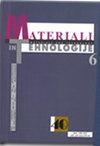MECHANICAL BEHAVIOUR OF INFLORESCENCE/GLASS-FIBRE-REINFORCED HYBRID EPOXY COMPOSITES
IF 0.8
4区 材料科学
Q4 MATERIALS SCIENCE, MULTIDISCIPLINARY
引用次数: 0
Abstract
The biodegradability and environmental friendliness of natural fibres makes them suitable for implementation in a circular economy. As a result, several natural fibres and processing methods have evolved. The hydrophilic nature of ligno cellulose fibrils restricts the effective adhesion at the interface of fibre and matrix. The hybridization of natural fibres with synthetic fibres leads to promising characteristics of the resulting composite materials. This paper deals with the hybridization of conventional glass fibre and natural fibre extracted from coconut inflorescence. The effect of hybridization on the tensile and flexural strengths of surface-modified inflorescence fibre with glass fibres was investigated. The composites were fabricated using a hand-layup technique by varying the inflorescence fibre and glass-fibre reinforcement composition by (5, 10, 15 and 20) %. A notable improvement in the tensile and flexural strengths of 193.65 MPa and 240.69 MPa was observed for 85 % of glass and 15 % of benzoyl-chloride-modified inflorescence-fibre-reinforced hybrid composites. The elimination of amorphous constituents in the inflorescence fibres was checked by XRD and FTIR analyses. A surface-morphology analysis of unmodified and benzoyl-chloride-modified inflorescence fibres revealed pores and cavity formation on the fibril walls. These composites with superior mechanical properties can be an alternative to synthetic fibre composites and ensure the implementation of a circular economy and sustainable manufacturing.花序/玻璃纤维增强杂化环氧复合材料的力学性能
天然纤维的可生物降解性和环境友好性使它们适合在循环经济中实施。因此,一些天然纤维和加工方法得到了发展。木质纤维素原纤维的亲水性限制了纤维与基质界面的有效粘附。天然纤维与合成纤维的杂交使所得到的复合材料具有良好的特性。研究了从椰子花序中提取的常规玻璃纤维与天然纤维的杂交。研究了玻璃纤维杂交对表面改性花序纤维抗拉强度和抗弯强度的影响。复合材料是通过改变花序纤维和玻璃纤维增强成分(5、10、15和20)%的手工铺层技术制备的。85%的玻璃和15%的苯甲酰氯改性花序-纤维增强混杂复合材料的拉伸强度和弯曲强度分别提高了193.65 MPa和240.69 MPa。通过XRD和FTIR分析检查了花序纤维中无定形成分的消除。对未改性和苯甲酰氯化物改性的花序纤维进行表面形貌分析,发现纤维壁上有孔和空腔形成。这些具有优异机械性能的复合材料可以替代合成纤维复合材料,并确保循环经济和可持续制造的实施。
本文章由计算机程序翻译,如有差异,请以英文原文为准。
求助全文
约1分钟内获得全文
求助全文
来源期刊

Materiali in tehnologije
工程技术-材料科学:综合
CiteScore
1.30
自引率
0.00%
发文量
73
审稿时长
4-8 weeks
期刊介绍:
The journal MATERIALI IN TEHNOLOGIJE/MATERIALS AND TECHNOLOGY is a scientific journal, devoted to original papers and review scientific papers concerned with the areas of fundamental and applied science and technology. Topics of particular interest include metallic materials, inorganic materials, polymers, vacuum technique and lately nanomaterials.
 求助内容:
求助内容: 应助结果提醒方式:
应助结果提醒方式:


